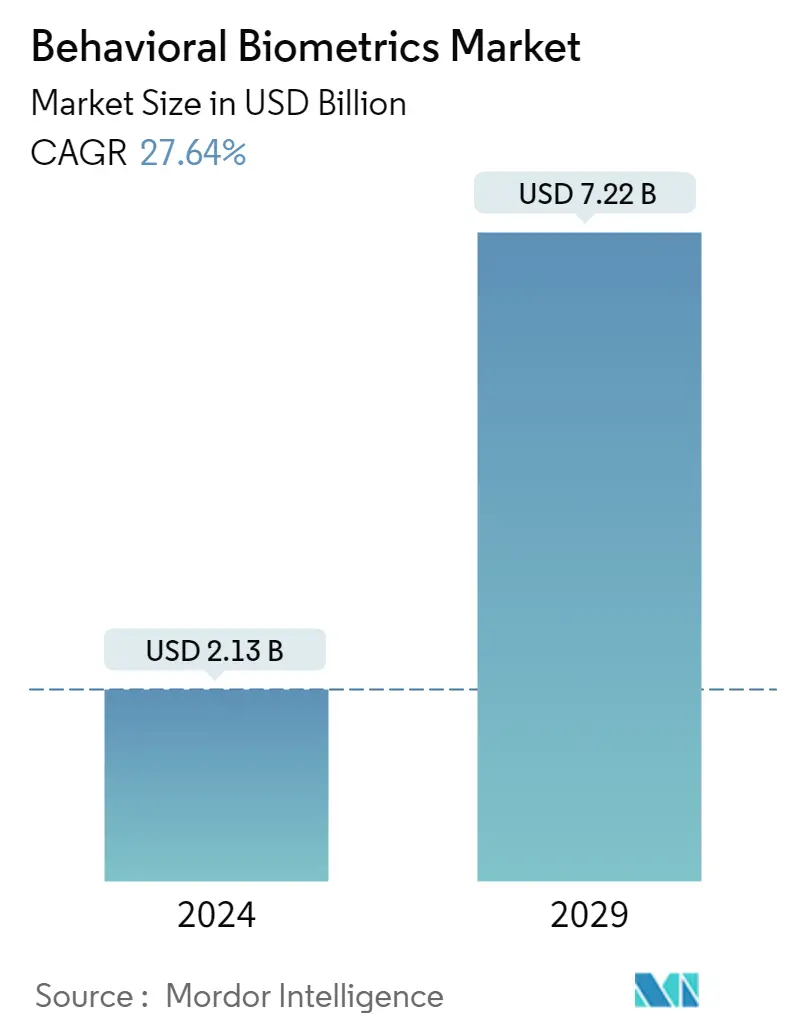
| Study Period | 2019 - 2029 |
| Market Size (2024) | USD 2.13 Billion |
| Market Size (2029) | USD 7.22 Billion |
| CAGR (2024 - 2029) | 27.64 % |
| Fastest Growing Market | Asia Pacific |
| Largest Market | North America |
| Market Concentration | Medium |
Major Players
*Disclaimer: Major Players sorted in no particular order |
Behavioral Biometrics Market Analysis
The Behavioral Biometrics Market size is estimated at USD 2.13 billion in 2024, and is expected to reach USD 7.22 billion by 2029, growing at a CAGR of 27.64% during the forecast period (2024-2029).
With the recent outbreak of the COVID-19 pandemic, organizations across the world must respond proactively to cyber threats that have witnessed a spike during the pandemic. Owing to this, cyber resilience, which refers to a sector or organization's ability to respond to, prepare for, and recover from cyberattacks, has become an absolute necessity rather than an option in the current scenario.
- Behavioral biometrics provides a new generation of user security solutions that identify individuals based on the unique way they interact with computer devices, such as smartphones, tablets, or mouse-screen-and-keyboard.
- By measuring everything from how the user holds the phone or how they swipe the screen, to which keyboard or gestural shortcuts they use, software algorithms build a unique user profile, which can then be used to confirm the user's identity on subsequent interactions.
- Behavioral biometrics does not replace the password or other legacy forms of identity authentication, but it does reduce the burden placed on them to protect sensitive data. Even the strongest password is only secure so long as it is secret. By offering an additional, continuous layer of identity assurance, behavioral biometrics prevents the password from being a single point of security failure.
- A growing number of threats are associated with the data compromising. This is resulting in significant loss to organizations, and compromising user credentials being highlighted as one of the major causes of global cyber threat.
- Similarly, according to the IBM report in 2020, major malicious breaches were caused by compromised credentials. Moreover, about 19% of all the malicious breaches were the cause behind malicious attacks in 2020.
Behavioral Biometrics Industry Segmentation
Behavioral biometrics analyzes various behavioral aspects, such as signature analysis, voice recognition, gait analysis, etc., in order to provide security solutions in various industries, such as BFSI, retail and e-commerce, government, and healthcare. The study categorizes various driving factors affecting the adoption of behavioral aspects across major end-user verticals. It also categorizes the applications of the behavioral biometrics solution across multiple industries.
| Signature Analysis |
| Keystroke Dynamics |
| Voice Recognition |
| Gait Analysis |
| On-premise |
| On-cloud |
| Identity Proofing |
| Continuous Authentication |
| Risk and Compliance |
| Fraud Detection and Prevention |
| BFSI |
| Retail and E-commerce |
| Healthcare |
| Government and Public Sector |
| Other End-user Verticals |
| North America |
| Europe |
| Asia Pacific |
| Rest of the World |
Behavioral Biometrics Market Size Summary
The behavioral biometrics market is poised for significant growth, driven by the increasing need for enhanced security measures in response to rising cyber threats. This technology offers a sophisticated approach to user authentication by analyzing unique patterns in how individuals interact with devices, such as smartphones and computers. By creating detailed user profiles based on these interactions, behavioral biometrics provides an additional layer of security that complements traditional methods like passwords. This is particularly crucial as cybercrime continues to escalate, with compromised credentials being a leading cause of security breaches. The financial services sector, in particular, is rapidly adopting this technology to safeguard customer data and enhance user experience, especially in the wake of new regulations and the rise of fintech competitors.
North America is expected to maintain a significant share of the behavioral biometrics market, fueled by substantial investments in cybersecurity and a strong focus on innovative security solutions. The region's governments are actively supporting the development of advanced biometric applications, further driving market growth. The competitive landscape of the market is characterized by strategic partnerships, acquisitions, and funding activities aimed at expanding technological capabilities and market reach. Companies like BioCatch and SecureAuth are leading these efforts, with recent acquisitions and funding rounds enhancing their positions in the global market. As organizations increasingly prioritize cyber resilience, the adoption of behavioral biometrics is set to rise, offering promising opportunities for market players.
Behavioral Biometrics Market Size - Table of Contents
1. MARKET DYNAMICS
- 1.1 Market Overview
-
1.2 Industry Attractiveness - Porters 5 Force Analysis
- 1.2.1 Threat of New Entrants
- 1.2.2 Bargaining Power of Buyers/Consumers
- 1.2.3 Bargaining Power of Suppliers
- 1.2.4 Threat of Substitute Products
- 1.2.5 Intensity of Competitive Rivalry
-
1.3 Market Drivers
- 1.3.1 Growth in Applications of Biometric Technology in the Commercial and Government Sectors
- 1.3.2 Increase in Online Transactions and Fraudulent Activities
-
1.4 Market Restraints
- 1.4.1 Privacy Intrusion Concerns
- 1.5 Impact of COVID-19 on the Behavioral Biometrics Industry
2. MARKET SEGMENTATION
-
2.1 Type
- 2.1.1 Signature Analysis
- 2.1.2 Keystroke Dynamics
- 2.1.3 Voice Recognition
- 2.1.4 Gait Analysis
-
2.2 Deployment
- 2.2.1 On-premise
- 2.2.2 On-cloud
-
2.3 Application
- 2.3.1 Identity Proofing
- 2.3.2 Continuous Authentication
- 2.3.3 Risk and Compliance
- 2.3.4 Fraud Detection and Prevention
-
2.4 End-User
- 2.4.1 BFSI
- 2.4.2 Retail and E-commerce
- 2.4.3 Healthcare
- 2.4.4 Government and Public Sector
- 2.4.5 Other End-user Verticals
-
2.5 Geography
- 2.5.1 North America
- 2.5.2 Europe
- 2.5.3 Asia Pacific
- 2.5.4 Rest of the World
Behavioral Biometrics Market Research FAQs
How big is the Behavioral Biometrics Market?
The Behavioral Biometrics Market size is expected to reach USD 2.13 billion in 2024 and grow at a CAGR of 27.64% to reach USD 7.22 billion by 2029.
What is the current Behavioral Biometrics Market size?
In 2024, the Behavioral Biometrics Market size is expected to reach USD 2.13 billion.


